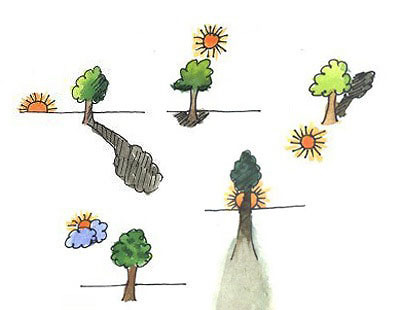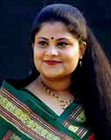
Landscape Painting – PART Ii

Shadow Effects
One of the most crucial aspects for getting a landscape painting to look authentic or realistic is to have the direction of the light consistent across all the elements in a painting. Actually, this 'rule' applies to any subject you're painting. When you're still at composition stage, you need to decide which direction the light is going to come from as this influences the shadows, contrasts, and colors.
 There are five options:
There are five options:
1. Side or Low Lighting
2. Back Lighting
3. Top Lighting
4. Front Lighting
5. Diffused or Overcast Lighting
It's well worthwhile playing around with an angle-poise lamp (if possible, use a daylight bulb) and a simple still-life setup to really get to grasp with light direction and shadows.
Move the lamp to the side, back, front, and into an elevated position. Put a sheet of paper over it to diffuse the light. Sketch the various scenes, taking particular note of where the shadows fall and where the highlights are. Look at the colors and how the different directions of light influence this and the appearance of the objects.
This knowledge will enable you to apply a light source consistently and effectively when painting (and it's still relevant even if you're painting from your imagination). It also helps interpret what you're looking at when you're painting a landscape and to be aware of how the light changes.
Note: The options are described here with application to a landscape painting, but apply equally to any subject.

Transparent Water drops
Transparent water drops are appealing things to paint. With a bit of practice and careful planning, you'll find they're not as impossible to paint as you might have thought.
The first thing to get decide is which direction the light is coming from in your painting as this will determine where the highlights and shadows in the drops will be.
Then apply the following 'rules':
There'll be a shadow underneath and to the opposite side of the light direction (in this illustration the light is coming from the right, so the shadow is underneath and to the left). Or just underneath if the light source is directly above.
There'll be a highlight on the top; not in the center but towards the side the light is coming from (right in this illustration). This is the light source reflected in the water drop.
There is a shadow at the top of the water drop (this may not seem logical, but it's caused by the refraction of light through the droplet from the shaded surface below).
There is a highlight at the bottom of the water drop (again this may not seem logical, but it's also caused by the refraction of the light through the drop, this time from the light source).
What Color Are Water Drops?
Water drops aren't the 'color of water;' rather being transparent, they're the color of whatever surface they're lying on. So if the leaf it's lying on is green, then the water looks green.
The highlight on the top of the drop will be white. The shadows are darker tones of the green. The refracted light at the bottom of the drop is a lighter tone of green. If the drop were on a red leaf, then the water drop would be in tones of red. The three drops above show this clearly.
Tips for painting water drops:
If you're working in watercolor, use masking fluid to preserve the highlight (reflected light in the drop) rather than trying to paint around it.
Until you're confident about your drops, sketch a drop first in pencil on a piece of paper before you paint it; if you've got the highlights and shadows correct, it'll look realistic.
Look for more details on landscape in the next issue and till then practice your shadow effect and water drops.
Remember: When it’s from HEART, it’s ART
Shyama Rangwala can be reached at (813) 843-6784, e-mail [email protected] or visit www.shyamshyama.com or check Shyama’s Art on Facebook.
Music
The Call of the Raaga: Classical Music in Hindi Cinema – PART iI

Who can forget the beautiful vocal renditions of the colossal classical maestro Ustad Bade Ghulam Ali Khan Saheb in film maker K. Asif’s magnum opus “Mughal-E-Azam” (1960) starring Madhubala as courtesan Anarkali and Dilip Kumar as the lovelorn medieval Mughal prince Salim? Under the highly effective and sublime music direction of Naushad, Ustab Bade Ghulam Ali Khan masterfully rendered “Shubh Din Aayo Raj Dulara” in raaga Rageshree and the romantic hymn “Prem Jogan Ban Gayi” in raaga Sohni. The latter is an evergreen ode to the intoxication of love. Lata Mangeshkar’s playful lilting ‘Mohe Panghat” based on raaga Ghara from the same movie is another attractive example of the percolation of classical music into Hindi cinema.
The strong foundation of North Indian classical music has influenced, inspired and initiated many genius creations in the field of Hindi film music. Versatile singer Manna Dey specialized in rendering classical based film songs, thus popularizing raagas even amongst lay listeners. The singer’s “Laga Chunari Mein Daag” (raaga Bhairavi), “Ketaki Gulab Juhi” (duet with Pandit Bhimsen Joshi in raaga Basant Bahar), “Bhay Banjana Vandana” (raaga Sur Malhar), “Aayo Kahan Se” (raaga Khamaj), “Phool Gendava Na Maro” (raaga Bhairavi), “Tu Chupi Hai Kaha” (raaga Malkauns), “Poocho Na Kaise Maine” (raaga Ahir Bhairav) are only some of the songs that have touched the hearts of music lovers.
One of the first Hindi talkie films was “Achhut Kanya” (1936) starring a young Ashok Kumar and the royal Devika Rani. Music by composer Saraswati Devi included a few memorable classical songs. Singing star Kurshid Bano’s “Ghata Ghana Ghor Ghor” based on raaga Sarang from the 1942 classic Tansen is another hauntingly captivating song. Honey-voiced thespian legendary singer Mohammad Rafi has also rendered many memorable classical based melodies, chief among them being “Man Tarapat Hari Charan” based on raaga Malkauns and “Oh Duniya Ke Rakhwale” (raaga Darbari) from the 1952 classic movie “Baiju Bawra.” Every song by composer Naushad in the film is a masterpiece in itself. Ustad Amir Khan has lent his inimitable voice to various compositions for this musical – a biopic based on the life of the singer/bard Baiju who is believed to have existed during the era of Mughal emperor Akbar in medieval North India when Mian Tansen reigned as musician supreme. “Mohe Bhool Gaye Sanwariya” by Lata is a resplendent gem based on raaga Kalingada. The most compelling musical duel based on raaga Desi belongs to a scene that pits the characters of Tansen (played by Surendra) and Baiju (played by Bharat Bhushan) in a battle of notes and vocal prowess powerful enough to melt stone. The playback vocal rendition by classical maestros Pandit D. V. Paluskar and Ustad Amir Khan is breathtaking.
Sitar maestro and composer extraordinaire Pandit Ravi Shankar has painted the most stunning melodies onto the canvas of the 1960 Hindi film “Anuradha.” Lata Mangeshkar’s vocal artistry shines in songs like “Saanware Saanware” in raaga Bhairavi and “Jane Kaise Sapano Mein” based on Tilak Shyam, which is a raaga created by Panditji himself. Whether it is Asha Bhosle’s adroit “Chota Sa Balma” from “Raagini,” Lata’s “Na Bole Na Bole” (Azaad), “Maayiri” and “Baiya Na Dharo” from “Dastak” or the queen of pure classicism - Kishori Amonkar’s “Geet Gaya Pattharo Ne,” the seduction of classical music is undeniable. South Indian singer Vani Jayaram became an overnight sensation in Hindi film music through classically influenced songs “Bole Re Pappi Hara” in raaga Malhar and “Hum ko Man Ki Shakti Dena” in raaga Kedar. Karnatic classical stalwart Yesudas became a household name among Hindi film music listeners with the pleasing melody “Jab Deep Jale Aana” in raaga Yaman from “Chitchor.”
In the dance ditty “Jhanak Jhanak Payal Baaje,” the song “Nain So Nain” peerlessly sung by Lata and Hemant Kumar is based on the rare raaga Malgunji. Even slapstick comedies like “Dekh Kabira Roya” gained some gravitas with classical compositions like Lata’s “Meri Veena Tum Bin Roye” (Raaga Ahir Bhairav). From the seamless songs of “Seema” (1955 – composer Shankar-Jaikishan) to the enthralling elegies of “Anarkali” (1953 – music by C. Ramchandra), from the glorious ghazals of “Mirza Ghalib” (1954 – composer Ghulam Mohammad) to the quotable qawwalis of “Barsat Ki Raat” (1960 – music director Roshan), Indian classical music in its various forms, styles, melodies, raagas, genres and sub-genres is happily entrenched in Hindi cinema.
While classicism in Hindi cinema music plateaued in the 1970s, 80s and 90s with a few exceptions, it has made a welcome return through the efforts of a whole new generation of composers and vocalists. With increased influence of popular and global culture, Hindi film music has changed and morphed into myriad exciting colors and forms. But the impact of classical music is still palpable and every now and then we are pleasantly surprised by a classical composition or two. There is a whole new breed of musicians putting its own unique twist on Hindi film music, creating dynamic fusions while still preserving the essence of classical music in Hindi cinema. Whether it is Shankar Mahadevan’s “Sapnon Se Bhare Naina” (Luck By Chance) based on raaga Bhairavi, Pritam’s “Mere Dholna” (Bhool Bhulaiya) based on raaga Jaijaiwanti or Shreya Ghoshal’s raaga Gurjari Todi duet with the late Ustad Bade Ghalam Ali Khan orchestrated through the magic of technology (from the movie “Delhi 6”), the classical melody in Hindi film music continues its onward journey!
Lavanya Dinesh, an accomplished performer and teacher of Hindustani classical vocal music, lives in Tampa. She regularly performs at musical venues in India and the United States. The singer has three album releases to her credit. She can be reached at [email protected]